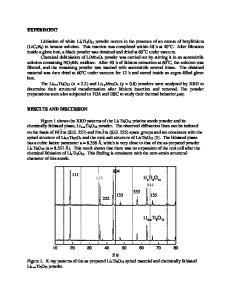Correlation between the trap state spectra and dielectric behavior of CaCu3Ti 4 O 12
- PDF / 457,214 Bytes
- 9 Pages / 584.957 x 782.986 pts Page_size
- 94 Downloads / 277 Views
.J. Luo, X.P. Song, C. Hang, and S.S. Chen Faculty of Physics & Electronic Technology, Hubei University, Wuhan 430062, People’s Republic of China
I.V. Medvedeva Institute of Metal Physics, Ural Division of the Russian Academy of Sciences, Ekaterinburg 620219, Russia
C.P. Yanga) Faculty of Physics & Electronic Technology, Hubei University, Wuhan 430062, People’s Republic of China; and State Key Laboratory of Metastable Materials Science and Technology, Yanshan University, Qinhuangdao 066004, People’s Republic of China (Received 14 June 2010; accepted 7 September 2010)
The temperature dependence of the various electric relaxation times in the perovskite oxide CaCu3Ti4O12 (CCTO) is determined (i) by trap state spectroscopy and (ii) by the dielectric loss function. A similarity in both number and properties of the (i) and (ii) relaxation times was found, suggesting that the dielectric response is strongly correlated with the trap state relaxation, although some differences remain. One or more dipoles developing charged trap states are considered responsible, and the experimental dielectric response of CCTO and Mn substituted CCTO are explored.
I. INTRODUCTION
The large dielectric response (up to 105)1 observed in CaCu3Ti4O12 (CCTO) has led to efforts to use this dielectric in various applications. This material shows many interesting properties: an unusual high-dielectric constant that is nearly temperature independent in the range from 100 K to 600 K; no phase transition and structure change until 35 K; and an abrupt drop of the dielectric constant below 100 K.1,2 Thus, CCTO has stimulated a fundamental physics interest in the origin of the unusually large dielectric constant.3 Normal ferroelectric behavior was rejected on the basis of the absence of ferroelectric domains and the fact that no phase transition was observed in this material.1,2,4 A high sensitivity to the sintering process as well as the sample annealing conditions was found, culminating in a noticeable change of the high-dielectric constant under varying conditions,5–7 suggesting extrinsic causes for the dielectric response.8–17 However, to date it is unclear how to describe that behavior in detail. Researchers have gravitated towards Maxwell-Wagner polarization,18 which occurs between the inhomogeneous conductive regions such as the surface barrier layer capacitance (SBLC) introduced by the depletion layers between a sample and an electrode mentioned by Lunkenheimer et al.8,19 and later detailed by a)
Address all correspondence to this author. e-mail: [email protected] DOI: 10.1557/jmr.2010.46 36
J. Mater. Res., Vol. 26, No. 1, Jan 14, 2011
http://journals.cambridge.org
Downloaded: 13 Mar 2015
Deng et al.20,21 using x-ray photoelectron spectroscopy (XPS) analysis with CCTO films; and the internal barrier layer capacitance (IBLC) at grain boundaries submitted by Sinclair et al.7,9,10 when they found semiconductive grains and insulating boundaries that were later proved by Chung et al.22; or at subgrain/domain boundaries that were advanced b
Data Loading...











